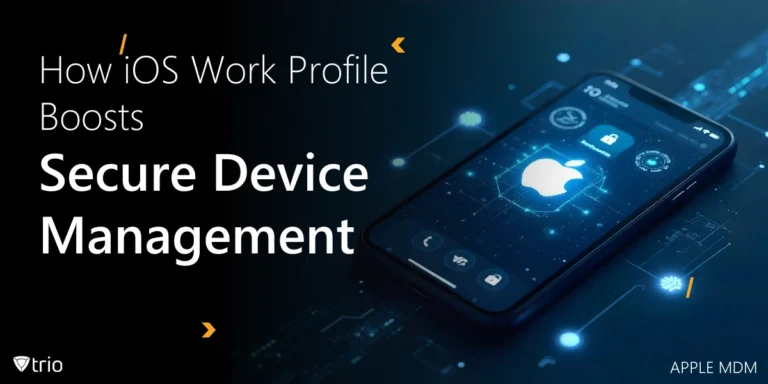When it comes to managing mobile devices in an organizational setting, the choice between On-Premises MDM and Cloud-Based MDM is a critical decision. In this blog post, we’ll take a closer look at On-Premises MDM, its advantages, considerations, and how it stacks up against cloud-based alternatives. Understanding these differences is essential for organizations aiming to establish a secure and effective mobile device management strategy.
What is On-Premises MDM?
Within the Building The term “mobile device management” (MDM) describes the use of MDM software inside a company’s own virtual or physical infrastructure as opposed to using cloud-based services. MDM is an essential part of business mobility management, which focuses on managing and safeguarding mobile devices—like tablets and smartphones—within a company’s network.
In the context of On-Premises MDM, the entire MDM infrastructure, including servers and databases, is hosted and managed internally by the organization. This approach offers a higher degree of control and customization compared to cloud-based MDM solutions. On-premises solutions are typically managed through a centralized console that allows administrators to enforce security policies, configure device settings, deploy applications, and monitor the status of mobile devices connected to the corporate network.
The primary advantage of On-Premises MDM is the direct control it provides to organizations over their mobile device management infrastructure. This control is especially critical for businesses operating in highly regulated industries or those with specific security and compliance requirements. On-premises deployment also enables organizations to have a more tailored and fine-grained approach to device management, ensuring that security policies align precisely with organizational needs.
While On-Premises MDM offers increased control, it also requires organizations to invest in and maintain their infrastructure, which includes hardware, software, and ongoing maintenance. In contrast, the infrastructure of cloud-based MDM systems is overseen by an outside service provider. The decision between cloud-based and on-premises MDM ultimately comes down to a number of variables, including the organization’s overall IT strategy, security preferences, and the requirement to comply with regulations.

On-premises MDMs vs Cloud-Based MDMs
On-premises MDM (Mobile Device Management) and Cloud-Based MDM are two distinct approaches to managing and securing mobile devices within an organizational setting. Though, according to O’Rielly, most companies are adopting the cloud, whether it be for MDMs or other tools, each approach has its advantages and considerations, making the choice between them dependent on specific organizational needs. Let’s compare the two using this MDM list of pros and cons:
Advantages of On-Premises MDM
- Enhanced Control: On-premises MDM provides organizations with direct control over their MDM infrastructure. This level of control is crucial for organizations with specific security and compliance requirements, allowing them to tailor configurations and policies to meet their unique needs.
- Data Privacy and Sovereignty: Organizations often have concerns about the geographic location of their data. On-premises MDM ensures that sensitive information stays within the organization’s physical or virtual boundaries, addressing data privacy and sovereignty concerns.
- Customization: On-premises solutions offer a high degree of customization. Organizations can define and enforce security policies that align precisely with their security and operational requirements.
Considerations of On-Premise MDM
- Infrastructure and Maintenance: On-premises deployment requires organizations to invest in and maintain their infrastructure, including hardware, software, and ongoing maintenance. This can result in higher upfront costs and ongoing responsibilities.
- Scalability: Organizations need to ensure that the On-Premises MDM solution can scale effectively to accommodate a growing number of devices and evolving security needs.
Advantages of Cloud-Based MDM
- Ease of Deployment: Cloud-based MDM solutions often have quicker deployment times since the infrastructure is managed by a third-party service provider. This can be beneficial for organizations looking for rapid implementation.
- Cost Efficiency: Cloud solutions typically involve lower upfront costs, as organizations don’t need to invest in their infrastructure. This cost model can be advantageous for smaller businesses or those looking for a more predictable cost structure.
- Automatic Updates and Maintenance: Cloud-based solutions usually include automatic updates and maintenance, reducing the burden on internal IT teams. This ensures that the MDM system remains up-to-date with the latest security features.
Considerations of Cloud-Based MDM
- Dependency on Internet Connection: Cloud-based solutions rely on Internet connectivity. If there are connectivity issues, it may impact the ability to manage and secure mobile devices effectively.
- Data Security Concerns: Some organizations, particularly those in highly regulated industries, may have concerns about storing sensitive data in the cloud. It’s crucial to choose a reputable cloud service provider with strong security measures.
- Limited Customization: While cloud-based solutions offer convenience, they might have limitations in terms of customization compared to On-Premises solutions.
Various considerations, including organizational preferences, security requirements, regulatory compliance demands, and overall IT strategy, influence the decision between On-Premises and Cloud-Based MDM. Both strategies offer advantages, and the choice should be made in accordance with the organization’s particular objectives and limitations.
See Trio in Action: Get Your Free Trial Now!
Conclusion
As of now, our MDM solution, Trio, provides a cloud-based approach to MDMs. This means we’re a cheaper, easy-to-use, and scalable option if you get Trio right now. In case you’re looking for an on-premises MDM, we’ll have you covered soon (we’re still perfecting our on-premises approach and haven’t released it yet). All in all, the choice between an on-premises MDM and a cloud-based one depends on the size of your organization, your budget, and the nature of the work you do.




